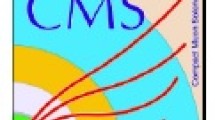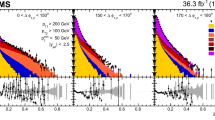Abstract
We present stdies of events triggered on two high-p T jets, produced inpp collisions at the CERN Intersecting Storage Rings (ISR) at\(\sqrt s \)=63 GeV, using a large solid angle calorimeter. The cross-section for producing two jets is measured in the dijet mass range 17–50 GeV/c2. A high-statistics sample of dijet events, where each jet has transverse energy above 10 GeV, is used to study the structure of jets and the associated event. We find the longitudinal fragmentation function to be similar to that of jets emerging frome + e − collisions but considerably harder than that observed at the Super Proton Synchrotron (SPS)\(p\bar p\) Collider. A steepening of the fragmentation function is observed when increasing the jet energy. Studies of the charge distribution in jets show that these predominantly originate from fragmenting valence quarks. The transverse energy and particle flows are presented as functions of the azimuthal distance from the jet axis.
Similar content being viewed by others
References
T. Åkesson et al.: Phys. Lett.118B, 185 and 193 (1982)
A.L.J. Angelis et al.: Phys. Lett.126B, 132 (1983)
T. Åkesson et al.: Phys. Lett.123B, 133 (1983); T. Åkesson et al.: Phys. Lett.128B, 354 (1983)
M. Banner et al.: Phys. Lett.118B, 203 (1982); G. Arnison et al.: Phys. Lett.121B, 115 (1983)
C. de Marzo et al.: Phys. Lett.112B, 173 (1982); C. de Marzo et al.: Nucl. Phys.B211, 375 (1983)
B. Brown et al.: Phys. Rev. Lett.49, 711 (1982); W. Selove et al.: Proc. 21st Int. Conf. on High Energy Physics, Paris, 1982, J. Phys.43, Suppl. 12, C3-131 (1982)
R. Horgan, M. Jacob: Nucl. Phys.B179, 441 (1981); T. Åkesson, H.U. Bengtsson: Phys. Lett.120B, 233 (1983); R. Odorico: Nucl. Phys.B228, 381 (1983)
M. Althoff et al.: Z. Phys. C—Particles and Fields22, 307 (1984); D. Bender et al.: Phys. Rev.D31, 1 (1985)
M. Jacob: Proc. 22nd Int. Conf. on High Energy Physics, Leipzig, 1984 (Akademie der Wissenschaften der DDR, Leipzig, 1984), vol. 2, p. 150, and references therein
T. Åkesson et al.: Z. Phys. C-Particles and Fields25, 13 (1984)
H. Gordon et al.: Nucl. Instrum. Methods196, 303 (1982); O. Botner et al.: Nucl. Instrum. Methods196, 315 (1982)
O. Botner et al.: Nucl. Instrum. Methods179, 45 (1981); T. Åkesson et al.: Preprint CERN-EP/85-80, submitted to Nucl. Instrum. Methods (1985)
D. Cockerill et al.: Phys. Scr.23, 649 (1981)
L. Rosselet: Proc. Topical Conference on the Application of Microprocessors to High Energy Physics Experiments, CERN, Geneva, 1981, CERN 81-07, p.316 (1981)
F. Paige, S. Protopopescu: BNL 31987 (1982) and BNL 29777 (1981), with updates to version 4.0
R.D. Field, R.P. Feynman: Phys. Rev.D15, 2590 (1977); R.D. Field, R.P. Feynman: Nucl. Phys.B138, 1 (1978)
Z. Koba, H.B. Nielsen, P. Olesen: Nucl. Phys.B40, 317 (1972)
D.W. Duke, J.F. Owens: Phys. Rev.D30, 49 (1984)
O. Benary et al.: BNL Internal Report OG-613 (1981) and AFS Internal Note 313 (1981)
R. Bock et al.: Nucl. Instrum. Methods186, 533 (1981)
P. Ghez: To appear in Proc. 5th Topical Workshop on Proton-Antiproton Physics, Saint-Vincent, 1985
G. Arnison et al.: Phys. Lett.132B, 223 (1983)
R. Brandelik et al.: Phys. Lett.100B, 357 (1981)
We use the parametrization for minimum bias events:\(dE_T /dy = \left[ { - 0.571 + 0.485\ln \left( {\sqrt s /GeV} \right)} \right]GeV\) obtained by integration of data in: B. Alper et al.: Nucl. Phys.B100, 237 (1975), and K. Guettler et al.: Phys. Lett.64B, 111 (1976)
H. Bøggild: Multiplicity correlations in events triggered on jets, compared with minimum bias ande + e −, AFS Internal Note 427 (1984), and Sect. 4.5 of this paper
Author information
Authors and Affiliations
Consortia
Rights and permissions
About this article
Cite this article
The Axial Field Spectrometer Collaboration., Åkesson, T., Albrow, M.G. et al. Dijet production cross-section and fragmentation of jets produced inp p collisions at\(\sqrt s \)=63 GeV. Z. Phys. C - Particles and Fields 30, 27–43 (1986). https://doi.org/10.1007/BF01560675
Received:
Issue Date:
DOI: https://doi.org/10.1007/BF01560675




